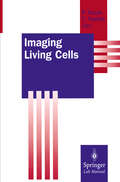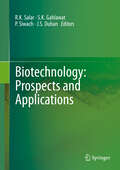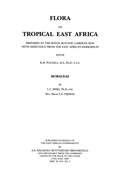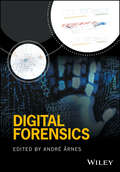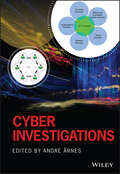- Table View
- List View
Imaging Living Cells (Springer Lab Manuals)
by Rosario Rizzuto Cristina FasolatoIntended for bench-top use, this lab manual is suitable for both scientists and graduate students, since it combines an update on the most advanced imaging procedures with detailed protocols. Examples, carefully selected from the wide repertoire of cell pyhsiology, cover such different functional aspects as distribution of multiple ions, electrical activity, exo-endocytosis, gene expression, and the cell cycle.
Biotechnology: Prospects and Applications
by R.K. Salar, S.K. Gahlawat, P. Siwach and J.S. DuhanBiotechnology: Prospects and Applications covers the review of recent developments in biotechnology and international authorship presents global issues that help in our understanding of the role of biotechnology in solving important scientific and societal problems for the benefit of mankind and environment. A balanced coverage of basic molecular biology and practical applications, relevant examples, colored illustrations, and contemporary applications of biotechnology provide students and researchers with the tools and basic knowledge of biotechnology. In our effort to introduce students and researchers to cutting edge techniques and applications of biotechnology, we dedicated specific chapters to such emerging areas of biotechnology as Emerging Dynamics of Brassinosteroids Research, Third generation green energy, Bioremediation, Metal Organic Frameworks: New smart materials for biological application, Bioherbicides, Biosensors, Fetal Mesenchymal Stem Cells and Animal forensics. Biotechnology: Prospects and Applications will be highly useful for students, teachers and researchers in all disciplines of life sciences, agricultural sciences, medicine, and biotechnology in universities, research stations and biotechnology companies. The book features broader aspects of the role of biotechnology in human endeavor. It also presents an overview of prospects and applications while emphasizing modern, cutting-edge, and emerging areas of biotechnology. Further, it provides the readers with a comprehensive knowledge of topics in food and agricultural biotechnology, microbial biotechnology, environmental biotechnology and animal biotechnology. The chapters have been written with special reference to the latest developments in above broader areas of biotechnology that impact the biotechnology industry. A list of references at the end of each chapter is provided for the readers to learn more about a particular topic. Typically, these references include basic research, research papers, review articles and articles from the popular literature.
Flora of Tropical East Africa - Moraceae (1989)
by R.M. POLHILL, B.A., Ph.D., F.L.S.; C.C. BERG, Ph.D.; Mrs. Maria E.E. HIJMANThis book is a comprehensive review of the genera of Moraceae, a family of flowering plants, found in the tropical region of East Africa. It presents information on their character, occurrence, habitat, phenotypic variations and distribution of each of the species under these genera.
Digital Forensics
by Andr RnesThe definitive text for students of digital forensics, as well as professionals looking to deepen their understanding of an increasingly critical field Written by faculty members and associates of the world-renowned Norwegian Information Security Laboratory (NisLab) at the Norwegian University of Science and Technology (NTNU), this textbook takes a scientific approach to digital forensics ideally suited for university courses in digital forensics and information security. Each chapter was written by an accomplished expert in his or her field, many of them with extensive experience in law enforcement and industry. The author team comprises experts in digital forensics, cybercrime law, information security and related areas. Digital forensics is a key competency in meeting the growing risks of cybercrime, as well as for criminal investigation generally. Considering the astonishing pace at which new information technology – and new ways of exploiting information technology – is brought on line, researchers and practitioners regularly face new technical challenges, forcing them to continuously upgrade their investigatory skills. Designed to prepare the next generation to rise to those challenges, the material contained in Digital Forensics has been tested and refined by use in both graduate and undergraduate programs and subjected to formal evaluations for more than ten years. Encompasses all aspects of the field, including methodological, scientific, technical and legal matters Based on the latest research, it provides novel insights for students, including an informed look at the future of digital forensics Includes test questions from actual exam sets, multiple choice questions suitable for online use and numerous visuals, illustrations and case example images Features real-word examples and scenarios, including court cases and technical problems, as well as a rich library of academic references and references to online media Digital Forensics is an excellent introductory text for programs in computer science and computer engineering and for master degree programs in military and police education. It is also a valuable reference for legal practitioners, police officers, investigators, and forensic practitioners seeking to gain a deeper understanding of digital forensics and cybercrime.
Cyber Investigations
by André ÅrnesCYBER INVESTIGATIONS A classroom tested introduction to cyber investigations with real-life examples included Cyber Investigations provides an introduction to the topic, an overview of the investigation process applied to cyber investigations, a review of legal aspects of cyber investigations, a review of Internet forensics and open-source intelligence, a research-based chapter on anonymization, and a deep-dive in to multimedia forensics. The content is structured in a consistent manner, with an emphasis on accessibility for students of computer science, information security, law enforcement, and military disciplines. To aid in reader comprehension and seamless assimilation of the material, real-life examples and student exercises are provided throughout, as well as an Educational Guide for both teachers and students. The material has been classroom-tested and is a perfect fit for most learning environments. Written by a highly experienced author team with backgrounds in law enforcement, academic research, and industry, sample topics covered in Cyber Investigations include: The cyber investigation process, including developing an integrated framework for cyber investigations and principles for the integrated cyber investigation process (ICIP) Cyber investigation law, including reasonable grounds to open a criminal cyber investigation and general conditions for privacy-invasive cyber investigation methods Perspectives of internet and cryptocurrency investigations, including examples like the proxy seller, the scammer, and the disgruntled employee Internet of things (IoT) investigations, including types of events leading to IoT investigations and new forensic challenges in the field Multimedia forensics facilitates the understanding of the role of multimedia in investigations, including how to leverage similarity matching, content-based tracing, and media metadata. Anonymization networks discusses how such networks work, and how they impact investigations? It addresses aspects of tracing, monitoring, evidence acquisition, de-anonymization, and large investigations Based on research, teaching material, experiences, and student feedback over several years, Cyber Investigations is ideal for all students and professionals in the cybersecurity industry, providing comprehensive subject coverage from faculty, associates, and former students of cyber security and digital forensics at the Norwegian University of Science and Technology (NTNU).
13 Amp plug and heater (large print)
by RnibThis page shows a labelled diagram of a UK 13 Amp plug connected to an electric heater. The plug has its top removed to reveal its internal wiring and the heater has its cover removed. There is a locator dot shown, which will be at the top left of the page when the image is the correct way up. The heater is to the left of the page. It has its cover removed. Its components are attached to a square backing plate that fills most of the left of the page. At the top, are the two heating elements made of coiled wire connected to the switch to the right and to the mains cable down and right. The earth wire is screwed to a terminal on the bottom of the heaters backing plate. The thick cable extends from the bottom left of the heater to where it is clamped to the plug on the right of the page. The three wires emerge from the cable and connect to the three screw terminals marked neutral, earth and live. The fuse is shown just down the page from the live terminal.
13 Amp plug and heater (UEB contracted)
by RnibThis page shows a labelled diagram of a UK 13 Amp plug connected to an electric heater. The plug has its top removed to reveal its internal wiring and the heater has its cover removed. There is a locator dot shown, which will be at the top left of the page when the image is the correct way up. The heater is to the left of the page. It has its cover removed. Its components are attached to a square backing plate that fills most of the left of the page. At the top, are the two heating elements made of coiled wire connected to the switch to the right and to the mains cable down and right. The earth wire is screwed to a terminal on the bottom of the heaters backing plate. The thick cable extends from the bottom left of the heater to where it is clamped to the plug on the right of the page. The three wires emerge from the cable and connect to the three screw terminals marked neutral, earth and live. The fuse is shown just down the page from the live terminal.
13 Amp plug and heater (UEB uncontracted)
by RnibThis page shows a labelled diagram of a UK 13 Amp plug connected to an electric heater. The plug has its top removed to reveal its internal wiring and the heater has its cover removed. There is a locator dot shown, which will be at the top left of the page when the image is the correct way up. The heater is to the left of the page. It has its cover removed. Its components are attached to a square backing plate that fills most of the left of the page. At the top, are the two heating elements made of coiled wire connected to the switch to the right and to the mains cable down and right. The earth wire is screwed to a terminal on the bottom of the heaters backing plate. The thick cable extends from the bottom left of the heater to where it is clamped to the plug on the right of the page. The three wires emerge from the cable and connect to the three screw terminals marked neutral, earth and live. The fuse is shown just down the page from the live terminal.
Absorbing infrared radiation (large print)
by RnibThere are two labelled images on this page showing how infrared radiation is absorbed and reflected by a smooth surface and a matt surface. There is a locator dot shown, which will be at the top left of the page when the image is the correct way up. At the top of the page is an image of a beam of infrared radiation hitting a smooth surface. The radiation is represented by arrows. It starts in the top left of the image, goes down and right, strikes the smooth surface and is reflected down and left. Part of the energy of the radiation is absorbed where it strikes the surface. At the bottom of the page is an image of a beam of infrared radiation hitting a matt surface. It starts in the left of the image, goes down and right, strikes the matt surface and is reflected up and right. It then strikes the matt surface again and is reflected down and left. Part of the energy of the radiation is absorbed in the places where it strikes the surface.
Absorbing infrared radiation (UEB contracted)
by RnibThere are two labelled images on this page showing how infrared radiation is absorbed and reflected by a smooth surface and a matt surface. There is a locator dot shown, which will be at the top left of the page when the image is the correct way up. At the top of the page is an image of a beam of infrared radiation hitting a smooth surface. The radiation is represented by arrows. It starts in the top left of the image, goes down and right, strikes the smooth surface and is reflected down and left. Part of the energy of the radiation is absorbed where it strikes the surface. At the bottom of the page is an image of a beam of infrared radiation hitting a matt surface. It starts in the left of the image, goes down and right, strikes the matt surface and is reflected up and right. It then strikes the matt surface again and is reflected down and left. Part of the energy of the radiation is absorbed in the places where it strikes the surface.
Absorbing infrared radiation (UEB uncontracted)
by RnibThere are two labelled images on this page showing how infrared radiation is absorbed and reflected by a smooth surface and a matt surface. There is a locator dot shown, which will be at the top left of the page when the image is the correct way up. At the top of the page is an image of a beam of infrared radiation hitting a smooth surface. The radiation is represented by arrows. It starts in the top left of the image, goes down and right, strikes the smooth surface and is reflected down and left. Part of the energy of the radiation is absorbed where it strikes the surface. At the bottom of the page is an image of a beam of infrared radiation hitting a matt surface. It starts in the left of the image, goes down and right, strikes the matt surface and is reflected up and right. It then strikes the matt surface again and is reflected down and left. Part of the energy of the radiation is absorbed in the places where it strikes the surface.
Absorption and penetration of atomic radiation (large print)
by RnibThis is a two-page document showing labelled diagrams of an apparatus for measuring absorption and penetration of atomic radiation, and how different materials absorb or block atomic radiation. There is a locator dot shown on each page, which will be at the top left when the image is the correct way up. The diagram on page two is surrounded by a dashed line image border. Page 1: This diagram shows the apparatus for measuring the number of particles absorbed by a material. It is seen from the side in cross section. The radioactive source is on the centre left of the page, the absorber in the centre and the Geiger tube, (the detector) on the centre right. Page 2: This diagram shows how paper, aluminium and lead block or transmit alpha, beta and gamma radiation. The radiation travels from the left of the page and strikes three sheets of the materials, which are seen from the side.
Absorption and penetration of atomic radiation (large print)
by RnibThis is a two-page document showing labelled diagrams of an apparatus for measuring absorption and penetration of atomic radiation, and how different materials absorb or block atomic radiation. There is a locator dot shown on each page, which will be at the top left when the image is the correct way up. The diagram on page two is surrounded by a dashed line image border. Page 1: This diagram shows the apparatus for measuring the number of particles absorbed by a material. It is seen from the side in cross section. The radioactive source is on the centre left of the page, the absorber in the centre and the Geiger tube, (the detector) on the centre right. Page 2: This diagram shows how paper, aluminium and lead block or transmit alpha, beta and gamma radiation. The radiation travels from the left of the page and strikes three sheets of the materials, which are seen from the side.
Absorption and penetration of atomic radiation (UEB contracted)
by RnibThis is a two-page document showing labelled diagrams of an apparatus for measuring absorption and penetration of atomic radiation, and how different materials absorb or block atomic radiation. There is a locator dot shown on each page, which will be at the top left when the image is the correct way up. The diagram on page two is surrounded by a dashed line image border. Page 1: This diagram shows the apparatus for measuring the number of particles absorbed by a material. It is seen from the side in cross section. The radioactive source is on the centre left of the page, the absorber in the centre and the Geiger tube, (the detector) on the centre right. Page 2: This diagram shows how paper, aluminium and lead block or transmit alpha, beta and gamma radiation. The radiation travels from the left of the page and strikes three sheets of the materials, which are seen from the side.
Absorption and penetration of atomic radiation (UEB contracted)
by RnibThis is a two-page document showing labelled diagrams of an apparatus for measuring absorption and penetration of atomic radiation, and how different materials absorb or block atomic radiation. There is a locator dot shown on each page, which will be at the top left when the image is the correct way up. The diagram on page two is surrounded by a dashed line image border. Page 1: This diagram shows the apparatus for measuring the number of particles absorbed by a material. It is seen from the side in cross section. The radioactive source is on the centre left of the page, the absorber in the centre and the Geiger tube, (the detector) on the centre right. Page 2: This diagram shows how paper, aluminium and lead block or transmit alpha, beta and gamma radiation. The radiation travels from the left of the page and strikes three sheets of the materials, which are seen from the side.
Absorption and penetration of atomic radiation (UEB uncontracted)
by RnibThis is a two-page document showing labelled diagrams of an apparatus for measuring absorption and penetration of atomic radiation, and how different materials absorb or block atomic radiation. There is a locator dot shown on each page, which will be at the top left when the image is the correct way up. The diagram on page two is surrounded by a dashed line image border. Page 1: This diagram shows the apparatus for measuring the number of particles absorbed by a material. It is seen from the side in cross section. The radioactive source is on the centre left of the page, the absorber in the centre and the Geiger tube, (the detector) on the centre right. Page 2: This diagram shows how paper, aluminium and lead block or transmit alpha, beta and gamma radiation. The radiation travels from the left of the page and strikes three sheets of the materials, which are seen from the side.
Absorption and penetration of atomic radiation (UEB uncontracted)
by RnibThis is a two-page document showing labelled diagrams of an apparatus for measuring absorption and penetration of atomic radiation, and how different materials absorb or block atomic radiation. There is a locator dot shown on each page, which will be at the top left when the image is the correct way up. The diagram on page two is surrounded by a dashed line image border. Page 1: This diagram shows the apparatus for measuring the number of particles absorbed by a material. It is seen from the side in cross section. The radioactive source is on the centre left of the page, the absorber in the centre and the Geiger tube, (the detector) on the centre right. Page 2: This diagram shows how paper, aluminium and lead block or transmit alpha, beta and gamma radiation. The radiation travels from the left of the page and strikes three sheets of the materials, which are seen from the side.
Acceleration formula (contracted)
by RnibThis diagram shows a standard formula triangle depicting the formula for acceleration. The triangle is split into three sections: top, right and left. The top section is labelled F for force, the left section is labelled A for acceleration, and the right section is labelled M for mass.
Acid Rain (large print)
by RnibThis diagram shows how acid rain results from industrial and car-related pollution. In the diagram there is: a factory with a chimney, a car, a lake, rain, trees, a mountain and clouds. There is a locator dot shown, which will be at the top left of the page when the image is the right way up. The diagram has a dashed line image border, arrows and text labels. All features are seen from the side. At the bottom left of the page is a section of land which stretches to the right. Up the page from this is a rectangular shaped factory with a chimney. Rising up the page from this are polluting gases which form clouds that stretch across to the right. There are four arrows pointing right, just down the page from these clouds, showing the wind direction. To the right of the factory is a car seen from the side, which is also emitting polluting gases. At the bottom centre of the page there is a lake. To the right of this is a snow-capped mountain with two trees which are growing on its slope. Rain is falling from the clouds on the top right of the image into the lake and onto the mountain slope. There are text labels describing features and processes in the diagram. The objects in the diagram are not shown to scale. All chemical symbols use the 2008 version of the UK braille science code.
Acid Rain (UEB contracted)
by RnibThis diagram shows how acid rain results from industrial and car-related pollution. In the diagram there is: a factory with a chimney, a car, a lake, rain, trees, a mountain and clouds. There is a locator dot shown, which will be at the top left of the page when the image is the right way up. The diagram has a dashed line image border, arrows and text labels. All features are seen from the side. At the bottom left of the page is a section of land which stretches to the right. Up the page from this is a rectangular shaped factory with a chimney. Rising up the page from this are polluting gases which form clouds that stretch across to the right. There are four arrows pointing right, just down the page from these clouds, showing the wind direction. To the right of the factory is a car seen from the side, which is also emitting polluting gases. At the bottom centre of the page there is a lake. To the right of this is a snow-capped mountain with two trees which are growing on its slope. Rain is falling from the clouds on the top right of the image into the lake and onto the mountain slope. There are text labels describing features and processes in the diagram. The objects in the diagram are not shown to scale. All chemical symbols use the 2008 version of the UK braille science code.
Acid Rain (UEB uncontracted)
by RnibThis diagram shows how acid rain results from industrial and car-related pollution. In the diagram there is: a factory with a chimney, a car, a lake, rain, trees, a mountain and clouds. There is a locator dot shown, which will be at the top left of the page when the image is the right way up. The diagram has a dashed line image border, arrows and text labels. All features are seen from the side. At the bottom left of the page is a section of land which stretches to the right. Up the page from this is a rectangular shaped factory with a chimney. Rising up the page from this are polluting gases which form clouds that stretch across to the right. There are four arrows pointing right, just down the page from these clouds, showing the wind direction. To the right of the factory is a car seen from the side, which is also emitting polluting gases. At the bottom centre of the page there is a lake. To the right of this is a snow-capped mountain with two trees which are growing on its slope. Rain is falling from the clouds on the top right of the image into the lake and onto the mountain slope. There are text labels describing features and processes in the diagram. The objects in the diagram are not shown to scale. All chemical symbols use the 2008 version of the UK braille science code.
Acids and Bases - pH Scale (tactile)
by RnibThis diagram shows a pH scale with examples of different substances at each point of the scale. There is a note saying to read the page sideways.
Active transport (large print)
by RnibThese pages show diagrams of different types of active transport. It is a multi-page image set on three pages. There is a locator dot shown on each page, which will be at the top left when the image is the correct way up. Active transport, transport protein: There are three diagrams on the page, each surrounded by a dashed image border. The transport protein is circular with a rounded recess in it. It is embedded in the cell membrane. In the first image it has got hold of a round molecule. In the second image it rotates taking the molecule into the cell. In the last image it returns to the original position, ready for a new molecule. The transport protein requires energy to do this work. Active transport, respiration: This page has a simple curved line graph. It shows that as the rate of active transport increases (Y-axis), the rate of respiration also increases (x-axis). Active transport, concentration gradient: This page shows a diagram of some plant roots shown in a cross section of soil. It is surrounded by a dashed line image border. Mineral ions are represented by small open circles. The concentration of ions in the root is higher than in the soil showing that active transport has moved the ions against a concentration gradient.
Active transport (large print)
by RnibThese pages show diagrams of different types of active transport. It is a multi-page image set on three pages. There is a locator dot shown on each page, which will be at the top left when the image is the correct way up. Active transport, transport protein There are three diagrams on the page, each surrounded by a dashed image border. The transport protein is circular with a rounded recess in it. It is embedded in the cell membrane. In the first image it has got hold of a round molecule. In the second image it rotates taking the molecule into the cell. In the last image it returns to the original position, ready for a new molecule. The transport protein requires energy to do this work. Active transport, respiration: This page has a simple curved line graph. It shows that as the rate of active transport increases (Y-axis), the rate of respiration also increases (x-axis). Active transport, concentration gradient: This page shows a diagram of some plant roots shown in a cross section of soil. It is surrounded by a dashed line image border. Mineral ions are represented by small open circles. The concentration of ions in the root is higher than in the soil showing that active transport has moved the ions against a concentration gradient.
Active transport (large print)
by RnibThese pages show diagrams of different types of active transport. It is a multi-page image set on three pages. There is a locator dot shown on each page, which will be at the top left when the image is the correct way up. Active transport, transport protein: There are three diagrams on the page, each surrounded by a dashed image border. The transport protein is circular with a rounded recess in it. It is embedded in the cell membrane. In the first image it has got hold of a round molecule. In the second image it rotates taking the molecule into the cell. In the last image it returns to the original position, ready for a new molecule. The transport protein requires energy to do this work. Active transport, respiration: This page has a simple curved line graph. It shows that as the rate of active transport increases (Y-axis), the rate of respiration also increases (x-axis). Active transport, concentration gradient: This page shows a diagram of some plant roots shown in a cross section of soil. It is surrounded by a dashed line image border. Mineral ions are represented by small open circles. The concentration of ions in the root is higher than in the soil showing that active transport has moved the ions against a concentration gradient.
